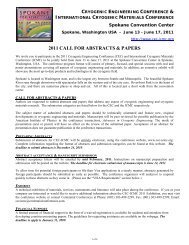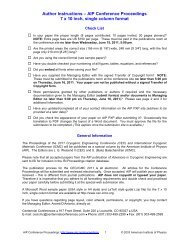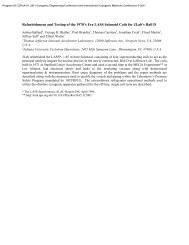CEC Abstracts in PDF format (as of 7/3/07) - CEC-ICMC 2013
CEC Abstracts in PDF format (as of 7/3/07) - CEC-ICMC 2013
CEC Abstracts in PDF format (as of 7/3/07) - CEC-ICMC 2013
You also want an ePaper? Increase the reach of your titles
YUMPU automatically turns print PDFs into web optimized ePapers that Google loves.
<strong>CEC</strong> 20<strong>07</strong> - <strong>Abstracts</strong><br />
C3-H-05 Performance <strong>of</strong> Helium Circulation System 1<br />
(HCS1)<br />
T. Takeda, M. Okamoto, K. Atsuda, A. Kobay<strong>as</strong>hi, K.<br />
Katagiri, Univ. <strong>of</strong> Tokyo.<br />
We have developed a system to collect evaporated helium g<strong>as</strong>, to cool it<br />
down to liquid and to return it <strong>in</strong>to a FRP dewar for MEG<br />
(Magnetoencephalography) us<strong>in</strong>g two GM cryocoolers without<br />
deliver<strong>in</strong>g any disturb<strong>in</strong>g noises to the MEG. The key idea is to utilize<br />
relatively high temperature helium g<strong>as</strong> (about 40K) cooled by the first<br />
stage <strong>of</strong> the GM cryocoolers to get rid <strong>of</strong> <strong>in</strong>vad<strong>in</strong>g heat to the dewar,<br />
but not to use liquid helium directly to keep the dewar cooled down.<br />
The g<strong>as</strong> is fed at the neck tube <strong>of</strong> the dewar. The evaporated helium g<strong>as</strong><br />
<strong>in</strong> the dewar is collected swiftly while it is <strong>in</strong> the low temperature<br />
(about 8K) and is returned to liquid without us<strong>in</strong>g much energy.<br />
A transfer tube that p<strong>as</strong>ses the liquid helium, the low temperature<br />
helium g<strong>as</strong> (about 8K) and the relatively high temperature helium g<strong>as</strong><br />
h<strong>as</strong> been developed to accomplish the above idea. A ref<strong>in</strong>er to collect<br />
the contam<strong>in</strong>at<strong>in</strong>g g<strong>as</strong>es such <strong>as</strong> oxygen and nitrogen effectively by<br />
freez<strong>in</strong>g the g<strong>as</strong>es is developed. It h<strong>as</strong> an electric heater to remove the<br />
frozen contam<strong>in</strong>ation <strong>in</strong> the form <strong>of</strong> g<strong>as</strong>es <strong>in</strong>to the air. A g<strong>as</strong> flow<br />
controller is also developed, which automatically control the heater to<br />
cleanup the contam<strong>in</strong>ation. The magnetic, vibrational and acoustic<br />
noises are attenuated to be low enough for MEG me<strong>as</strong>urements. The<br />
system can circulate at le<strong>as</strong>t 35.5 litters <strong>of</strong> evaporated liquid helium per<br />
day and usable at le<strong>as</strong>t for one year without any ma<strong>in</strong>tenance.<br />
C3-H-06 Design Parameters for Cryogenic<br />
Thermosyphons<br />
H. Tim<strong>in</strong>ger, B. David, R. Eckart, J. Overweg, Philips<br />
Research Europe-Hamburg.<br />
Cryogenic thermosyphons are the thermal conductors <strong>of</strong> choice for a<br />
variety <strong>of</strong> applications like e.g. conduction-cooled superconduct<strong>in</strong>g<br />
devices. They exhibit a small effective thermal resistance at small<br />
cross-sections. A careful design, however, is crucial to ensure<br />
sufficient heat transport for all possible heat loads. The aim <strong>of</strong> this<br />
work is to obta<strong>in</strong> experimental results on the effective thermal<br />
resistance dependent on the length, the cross-sectional area, and the<br />
work<strong>in</strong>g fluid fill level <strong>of</strong> a thermosyphon for different heat loads.<br />
For the experiments, a modular thermosyphon w<strong>as</strong> designed with 4<br />
different adiabatic tubes <strong>of</strong> length [cm]/cross-sectional area [sqcm]<br />
10/0.8, 10/3.14, 30/0.8, and 30/3.14, which can be mounted between<br />
condenser and evaporator. The thermosyphon w<strong>as</strong> operated with<br />
different fill-levels <strong>of</strong> either nitrogen or neon and different heat loads.<br />
The thermal resistance between condenser and evaporator w<strong>as</strong><br />
determ<strong>in</strong>ed, dependent on the design parameters mentioned above.<br />
Additionally, the useful temperature range <strong>of</strong> operation w<strong>as</strong><br />
determ<strong>in</strong>ed for nitrogen and neon. The results <strong>of</strong> the experiments are<br />
summarized <strong>in</strong> diagrams and provide useful reference data for the<br />
design <strong>of</strong> cryogenic thermosyphons.<br />
C3-I Fluid Mechanics - II<br />
C3-I-01 Surface oscillation <strong>of</strong> liquid nitrogen <strong>in</strong>duced by<br />
step reduction <strong>of</strong> gravity acceleration<br />
M. Stief, M.E. Dreyer, ZARM – Univ. <strong>of</strong> Bremen -<br />
Germany.<br />
For space application, which <strong>in</strong>volve the handl<strong>in</strong>g <strong>of</strong> cryogenic liquids<br />
e.g. liquid hydrogen or oxygen, the concern <strong>of</strong> free surface behavior<br />
upon change <strong>of</strong> acceleration level arises. With reduction <strong>of</strong> gravity<br />
acceleration hydrostatic loose there dom<strong>in</strong>ance and the free surface<br />
and therefore the motion <strong>of</strong> liquids is dom<strong>in</strong>ated by capillary forces.<br />
So far the characteristics <strong>of</strong> the fluid motion subjected to a sudden<br />
reduction <strong>of</strong> gravity acceleration h<strong>as</strong> been mostly <strong>in</strong>vestigated with<br />
conventional storable liquids. Because cryogenic liquids have<br />
different characteristics, these results provide only limited estimations<br />
for considered space applications. To overcome this knowledge gap<br />
experiments with liquid nitrogen <strong>in</strong>side partly filled right circular<br />
cyl<strong>in</strong>der have been performed at the droptower <strong>in</strong> Bremen, which<br />
provides 4.7s <strong>of</strong> very low gravity acceleration level and a steep<br />
transition from 1g to 0g. The oscillation <strong>of</strong> the free surface where<br />
optically observed by video system dur<strong>in</strong>g microgravity and processed<br />
for detection <strong>of</strong> the motion <strong>of</strong> the center location <strong>of</strong> the free surface<br />
and contact l<strong>in</strong>e <strong>of</strong> the liquid at the cyl<strong>in</strong>der wall.<br />
The fund<strong>in</strong>g <strong>of</strong> the research project by the German Aerospace Center<br />
(DLR) under grant numbers 50JR0011 and 50WM0241 is gratefully<br />
acknowledged.<br />
C3-I-02 Pressure drop <strong>of</strong> cable-<strong>in</strong>-conduit conductors<br />
with different void fraction<br />
C. Mar<strong>in</strong>ucci, P. Bruzzone, F. Staehli, EPFL, CRPP<br />
Fusion Technology; L. Bottura, CERN, AT Dept..<br />
Pressure drop cable-<strong>in</strong>-conduit conductors (CICC) w<strong>as</strong> me<strong>as</strong>ured at<br />
CRPP. The conductors are s<strong>in</strong>gle channel CICC’s with different void<br />
fraction <strong>in</strong> the range 38 to 28 %. Several conductor samples are<br />
<strong>in</strong>vestigated and tested <strong>in</strong> SULTAN by supercritical helium and <strong>in</strong> a<br />
room temperature facility by pressurized water. In particular,<br />
experiments are performed on samples at different degree <strong>of</strong><br />
compaction, me<strong>as</strong>ur<strong>in</strong>g the void fraction after each compression step.<br />
In this way it is possible to <strong>as</strong>sess the friction factor <strong>of</strong> the cable<br />
bundle <strong>as</strong> a function <strong>of</strong> the void fraction. The reduction <strong>of</strong> the<br />
experimental data to obta<strong>in</strong> the friction factor <strong>as</strong> a function <strong>of</strong><br />
Reynolds number is performed by (a) established methods us<strong>in</strong>g the<br />
correlation proposed by Katheder and (b) a new porous media analogy<br />
model. We discuss the results and <strong>in</strong> particular the comparison <strong>of</strong><br />
these two methods <strong>of</strong> correlation.<br />
C3-I-03 Flow <strong>of</strong> Saturated Liquid Nitrogen through<br />
Micro-Scale Orifices<br />
T.A. Jankowski, E.N. Schmierer, F.C. Prenger, S.P.<br />
Ashworth, Los Alamos National Laboratory.<br />
The flow <strong>of</strong> saturated liquid nitrogen through micro-scale orifices h<strong>as</strong><br />
been characterized experimentally. Me<strong>as</strong>urements <strong>of</strong> pressure drop<br />
and flow rate were made with liquid nitrogen flow<strong>in</strong>g through orifices<br />
rang<strong>in</strong>g <strong>in</strong> diameter from 35 micron to 250 micron, with orifice length<br />
to diameter ratios rang<strong>in</strong>g from 2 to 15. The design <strong>of</strong> the<br />
experimental apparatus, the <strong>in</strong>strumentation used, and the<br />
experimental uncerta<strong>in</strong>ties are presented. Difficulties with clogg<strong>in</strong>g<br />
<strong>of</strong> the micro-scale orifices and with obta<strong>in</strong><strong>in</strong>g repeatable and reliable<br />
results at cryogenic temperatures are discussed. F<strong>in</strong>ally, experimental<br />
results are shown to agree with previous <strong>in</strong>vestigations <strong>of</strong> flow<br />
through micro-scale orifices us<strong>in</strong>g room temperature refrigerants.<br />
C3-I-04 A Rotat<strong>in</strong>g Heat Pipe for Cool<strong>in</strong>g <strong>of</strong><br />
Superconduct<strong>in</strong>g Mach<strong>in</strong>es<br />
T.A. Jankowski, F.C. Prenger, E.N. Schmierer, Los<br />
Alamos National Laboratory; A. Razani, The<br />
University <strong>of</strong> New Mexico.<br />
A curved rotat<strong>in</strong>g heat pipe for use <strong>in</strong> superconduct<strong>in</strong>g motor and<br />
generator applications is <strong>in</strong>troduced here. A numerical model <strong>of</strong> the<br />
curved rotat<strong>in</strong>g heat pipe [1], which h<strong>as</strong> been validated with room<br />
temperature experiments, is used to predict the performance <strong>of</strong><br />
rotat<strong>in</strong>g heat pipes us<strong>in</strong>g cryogenic work<strong>in</strong>g fluids. Heat pipe model<br />
results are compared to results for a s<strong>in</strong>gle-ph<strong>as</strong>e g<strong>as</strong>-cooled<br />
refrigeration system <strong>in</strong> typical superconduct<strong>in</strong>g generators and motors.<br />
The nearly isothermal operation <strong>of</strong> the heat pipe is shown to reduce<br />
the temperature gradients seen by the superconduct<strong>in</strong>g coil compared<br />
to the forced flow g<strong>as</strong> system. Furthermore, because <strong>of</strong> the p<strong>as</strong>sive<br />
nature <strong>of</strong> the heat pipe operation, the heat pipe concept may be<br />
advantageous when consider<strong>in</strong>g the overall refrigeration system.<br />
F<strong>in</strong>ally, because <strong>of</strong> their modular nature, the use <strong>of</strong> multiple heat pipes<br />
provides redundancy <strong>in</strong> the cool<strong>in</strong>g system.<br />
[1] T. A. Jankowski, “Numerical and Experimental Investigations <strong>of</strong> a<br />
Rotat<strong>in</strong>g Heat Pipe,” Ph.D. Dissertation, The University <strong>of</strong> New<br />
Mexico, 20<strong>07</strong>.<br />
Page 42 <strong>of</strong> 53






